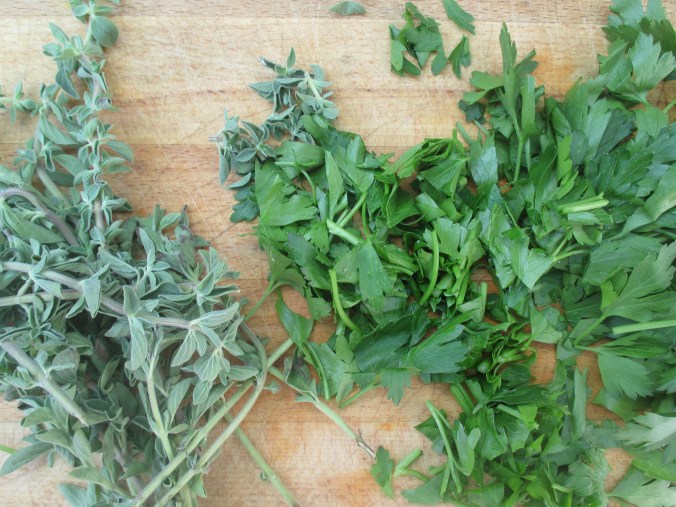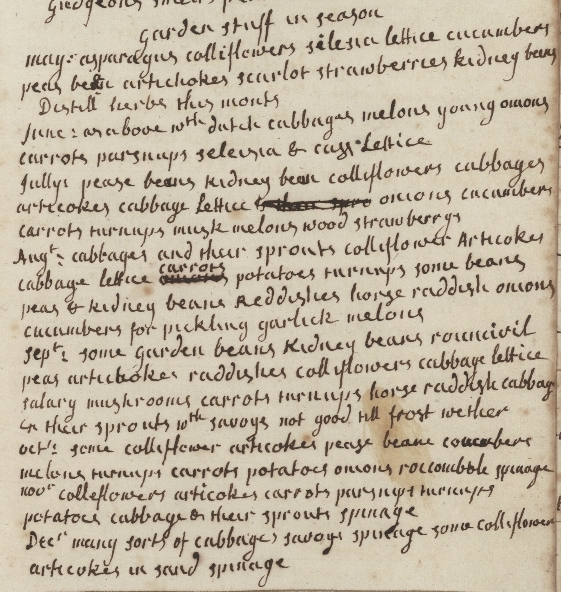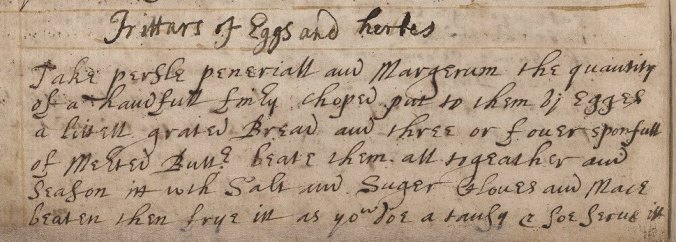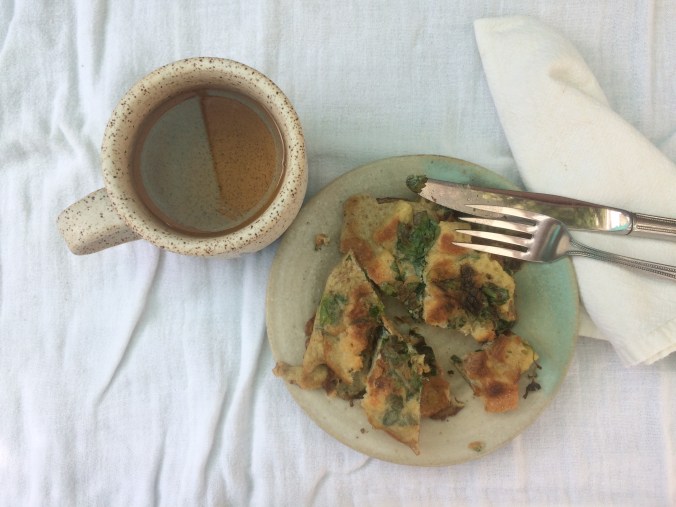This version of this post first appeared on the Folger Shakespeare Library’s Shakespeare and Beyond blog.

Frittars of eggs and herbs
Food is intimately connected to climate and season. It was for Shakespeare and his contemporaries: It is for us today. Beautiful, local produce is once again available in the northeast now that spring is turning into early summer.
In Shakespeare’s Love’s Labor’s Lost, Berowne insists that all things have their season “At Christmas I no more desire a rose / Than wish a snow in May’s new-fangled shows, / But like of each thing that in season grows (1.1.109-111). Roses do not thrive in winter; snow should not fall in May; Berowne appreciates all things in their proper season. In a recent New York Times article on food, diet, and climate, the authors concur about eating seasonally: “Anything that’s in season where you live, whether you buy it at a local farmers’ market or at a supermarket, is usually a good choice.” Early modern farmers and cooks often used almanacs to determine when it was the best time to harvest, preserve, and consume particular foods. (Read more about almanacs in this post by Katie Walker and learn more about diet regimes from Ken Albala’s book Eating Right in the Renaissance.)
A recipe book held at the Folger attributed to a Mrs. Knight from the eighteenth century lists “garden stuff in season” for the months of May through December (W.b.79, 54). Knight was concerned with what was in season in her garden and when it would be available to cook and preserve.

W.b.79, 54
may: asparagus colliflowers silesia lettice cucumbers
peas bean artichokes scarlot strawberries kidney beens
Distill herbs this month
June: as above with dutch cabbagas melons young onions
carrots parsnups seleisia & cass Lettice
Jullys: pease beans kidney bean colliflowers cabbages
artickoes cabbage lettice & then sproonions cucumbers
carrots turnups musk mellons wood strawberrys
August: cabbages and their sprouts colliflower Articokes
cabbage lettice carrots onionspotatoes turnups some beans
peas & kidney beans reddishes horse raddish onions
cucumbers for pickling garlick melons
In her list for May, she notes that asparagus, lettuce, and strawberries are in season. She also remarks that this is the ideal month to distill herbs into tonics and waters for medicinal and culinary uses throughout the year. All the items for May are still in season in June and they are joined by melons, young onions, and Dutch cabbages. In August, she notes that cucumbers for pickling are ripe and, perhaps, that pickling should commence to preserve those vegetables.
When I have an abundance of fresh herbs and vegetables, I often make fritters or frittata to quickly transform seasonal ingredients into something tasty and nutritious. Deb Perelman writes on Smitten Kitchen that a dish of zucchini fritters was inspired by “the zucchinis that seem to be growing in my fridge this summer; I never remember buying them but they’re always around.” I was excited to see a recipe for “Frittars of Eggs and herbes” in another Folger recipe book from the seventeenth century attributed to Lettice Pudsey (V.a.450, 2v)
The Recipe

Frittars of Eggs and herbes
Take persle peneriall and Margerum the quantity
of a handfull finly choped put to them vi egges
a littell grated Bread and three or fouer sponfull
of Melted Butter beate them all togeather and
season itt with Salt and Suger Cloues and Mace
beaten then frye itt as yow doe a tansy & soe serue itt

Frittars of eggs and herbs
Richly spiced with mace and clove and full flavorful fresh herbs, this savory fritter recipe is easy to prepare and satisfying as a main or side dish. When you have abundance of herbs and eggs to hand, this fritter will make good use of them. Serve with a bright salad, radishes, grilled asparagus, or other seasonal vegetables prepared simply.
A tansy, like a fritter, was an omelet-like egg dish that often included the herb tansy that also gave it its name. I tested this fritter mix as small fritters (about ¼ cup of the mix per fritter) and as a single, large fritter (rather like a frittata). Both were delicious. I’ve provided cooking instructions for both variations below. You might consider adding additional seasonal vegetables and reducing the amount of bread accordingly. The original recipe calls for “a littell grated Bread” and I decided to use chopped stale bread, instead of store-bought bread crumbs, for texture and binding. As small fritters and frittata, the batter soaked the bread and held together beautifully. I also left out the pennyroyal. Although it was used in early modern medicine and is still used in herbal remedies today, it can be toxic to humans and is far more difficult to procure than parsley and marjoram.
Eating seasonally requires culinary creativity. It is just this kind of creativity that Pudsey and Knight demonstrate in their recipe book and cooks today continue to explore and reinvent. By paying attention to what was growing in the garden, when it was ready to pick, and what might be done with it, Knight could make the most of her harvest. Since late spring and early summer is, in Knight’s account, a good time for harvesting and distilling seasonal herbs and Pudesy’s simple “frittar” recipe lets that abundance shine.
Updated Recipe
Serves 2 as a main, 4 as a side.
Parsley, one handful (approximately ½ cup) leaves and stems, washed and chopped
Marjoram or oregano, one handful (approximately ½ cup) leaves, washed and chopped
6 eggs
2 cups bread, torn or cut into small pieces
4 T melted butter, plus more for cooking
¼ t salt
1/8 t sugar
1/8 t ground cloves
1/8 t mace
Melt the butter. Set it aside and allow it to cool, Chop the greens and bread.
Lightly beat the eggs with a whisk in a large bowl and season with the salt, sugar, cloves, and mace. Stir in the parsley and marjoram. Stir in the melted butter. Stir in the bread pieces with a spoon or spatula.
To make many small fritters
Heat a large skillet, griddle, or non-stick frying pan. Grease with a small amount of butter.
Dollop fritter mix onto the pan using a ¼ cup measure. Do not crowd your fritters. Cook in batches if necessary.
Cook fritters for 2 minutes on one side and then flip them over and cook the other side for 2 minutes. They should be brown, but not burnt; cooked, but not overdone.
Serve immediately.
To make one, large fritter
Heat a 10-inch skillet or non-stick frying pan. Grease with a generous amount of butter.
Pour the fritter mix into the pan. Allow the fritter to cook undisturbed for 4 minutes. Using a spatula (or your preferred plate flipping method), turn your fritter over and cook for an additional 4-5 minutes. Test the center with a skewer to ensure that the fritter cooked on the inside when it looks beautifully browned on the outside.
Slice and serve immediately.










I’ve been going through your blog….and can i just say i absolutely LOVE it!! Love the idea behind the blog – taking recipes from archives is certainly very creative and fun! Really inspiring 🙂 thank you!
Thank you so much! Happy reading and cooking.